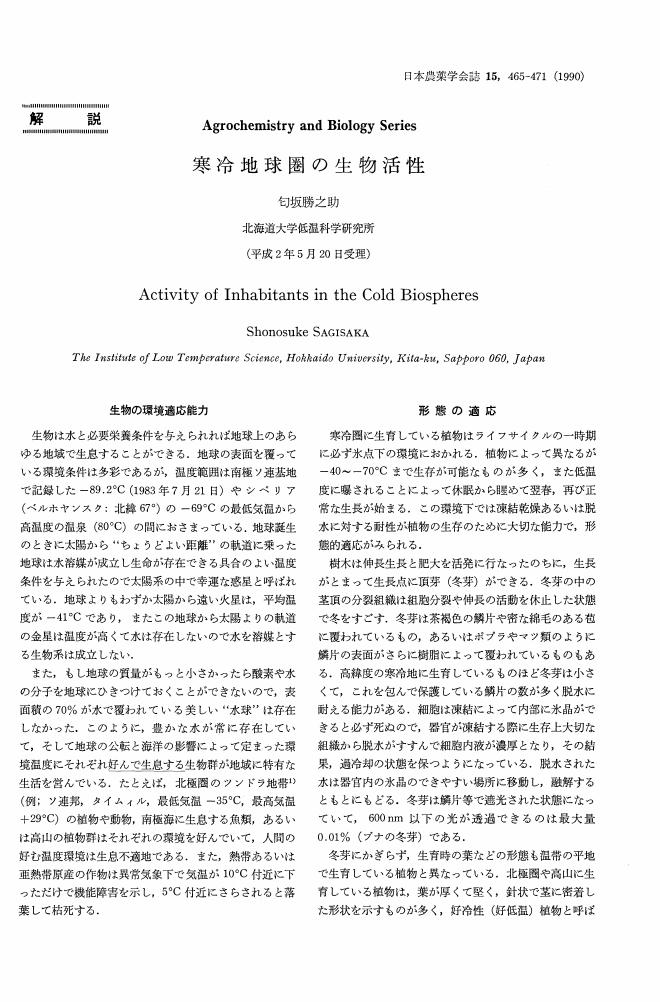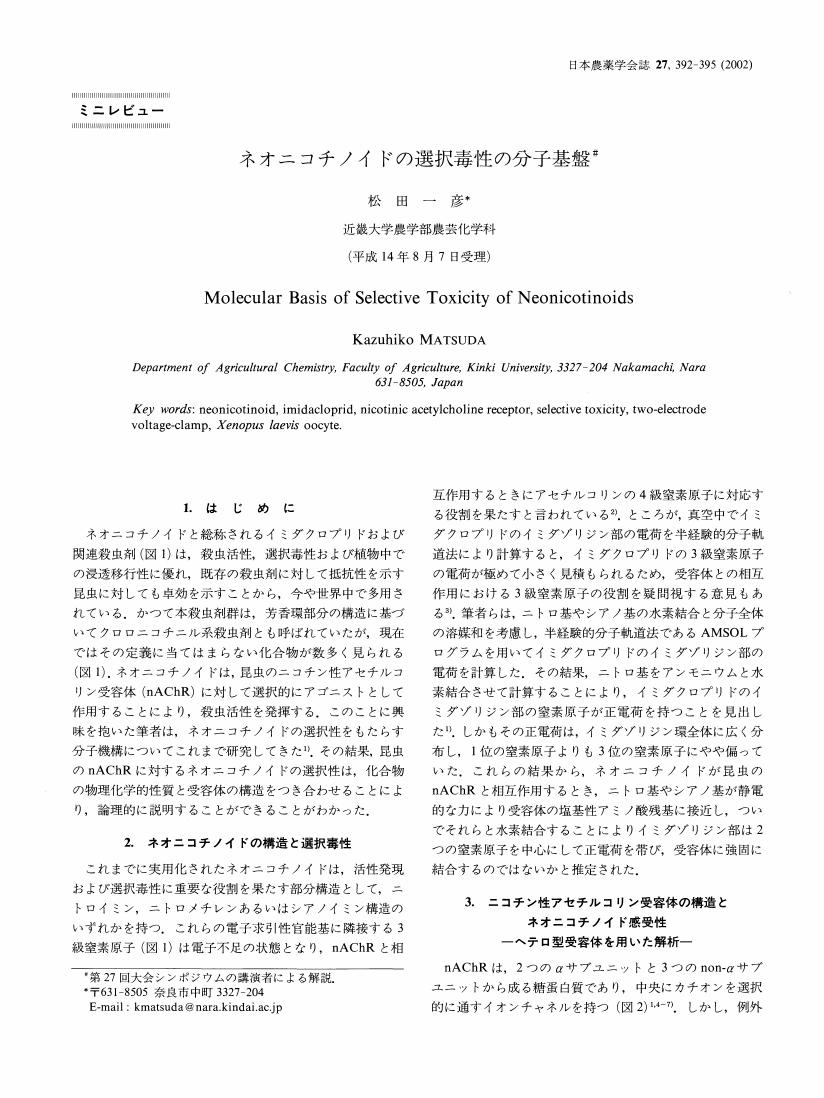1 0 0 0 OA 農薬開発における安全性試験とGLP
1 0 0 0 OA 寒冷地球圏の生物活性
- 著者
- 匂坂 勝之助
- 出版者
- 日本農薬学会
- 雑誌
- Journal of Pesticide Science (ISSN:1348589X)
- 巻号頁・発行日
- vol.15, no.3, pp.465-471, 1990-08-20 (Released:2010-08-05)
- 参考文献数
- 19
1 0 0 0 OA アブラナ科植物のファイトアレキシン
- 著者
- 門出 健次 高杉 光雄
- 出版者
- 日本農薬学会
- 雑誌
- Journal of Pesticide Science (ISSN:1348589X)
- 巻号頁・発行日
- vol.20, no.3, pp.339-343, 1995-08-20 (Released:2010-08-05)
- 参考文献数
- 16
- 著者
- Mushtaq Muhammad Naeem 春原 由香里 松本 宏
- 出版者
- 日本農薬学会
- 雑誌
- 日本農薬学会誌(Journal of Pesticide Science) (ISSN:1348589X)
- 巻号頁・発行日
- vol.38, no.2, pp.68-73, 2013
- 被引用文献数
- 11
<span style="font-variant: small-caps;">l</span>-DOPA (<span style="font-variant: small-caps;">l</span>-3,4-dihydroxyphenylalanine) is a bioactive secondary metabolite which inhibits growth of many weed species. However, its mode of action is not well elucidated in plants. The present studies were conducted to evaluate the effect of <span style="font-variant: small-caps;">l</span>-DOPA on root growth of cucumber (<i>Cucumis sativus</i> L.) and the possible involvement of quinoproteins (quinone-incorporated proteins) in phytotoxicity of <span style="font-variant: small-caps;">l</span>-DOPA. The results revealed that <span style="font-variant: small-caps;">l</span>-DOPA significantly inhibited root growth, induced cell death, increased polyphenol oxidase (PPO) activity, reduced free cysteine content, and enhanced quinoprotein formation in cucumber roots. The decrease in free cysteine content and increase in PPO activity suggested that quinones covalently bind with cysteine to form quinoproteins. The quinoproteins may be involved in phytotoxic action of <span style="font-variant: small-caps;">l</span>-DOPA in cucumber roots.
1 0 0 0 ヘテロ環を有するジクロベニル類縁化合物の除草活性
- 著者
- THOMAS J. W. ARMEL G. R. BEST M. D. Brosnan J. T. Klingeman W. E. Kopsell D. A. Bostic H. E. Vargas J. J. Do-Thanh C.
- 出版者
- 日本農薬学会
- 雑誌
- 日本農薬学会誌(Journal of Pesticide Science) (ISSN:1348589X)
- 巻号頁・発行日
- vol.38, no.4, pp.220-222, 2013
- 被引用文献数
- 1
Heterocyclic changes in the chemical structure of existing herbicides may provide new options for weed management. Pyridine and pyrimidine analogues of dichlobenil were evaluated for weed control in ornamental production. All compounds were preemergently applied at 1, 5, and 10 kg/ha to large crabgrass (<i>Digitaria sanguinalis</i>), common purslane (<i>Portulaca oleracea</i>), and Japanese holly (<i>Ilex crenata</i>). The pyrimidine analogue, 4,6-dichloropyrimidine-5-carbonitrile, controlled large crabgrass and common purslane similar to the active ingredient in dichlobenil at 10 kg/ha.
1 0 0 0 OA 環境水中の有機リン殺虫剤の消失における動物プランクトンの寄与
- 著者
- 柏田 祥策 持田 和男 尾添 嘉久 中村 利家
- 出版者
- 日本農薬学会
- 雑誌
- Journal of Pesticide Science (ISSN:1348589X)
- 巻号頁・発行日
- vol.20, no.4, pp.503-512, 1995-11-20 (Released:2010-08-05)
- 参考文献数
- 18
- 被引用文献数
- 1 3
汽水湖である宍道湖および中海から採集した優占動物プランクトン (それぞれ Sinocalanus tenellus およびOithona davisae) を含む5種の動物プランクトンの有機リン殺虫剤7種 (cyanophos, salithion, malathion, phenthoate, fenitrothion, diazinon および dichlofenthion) に対する耐性および分解能を評価するとともに, 春・秋期における両湖水のこれら殺虫剤の消失速度定数および両湖の動物プランクトン個体密度を用いて, 両湖水における殺虫剤消失に対する動物プランクトンの寄与率を算出した. S. tenellus および O. davisae の phenthoate および diazinon に対する耐性は, 試験したほかの農薬に対するそれらよりも低かった. 供試した5種の動物プランクトンによる農薬の分解は, 動物プランクトン種および農薬の種類によりそれぞれ異なるが, いずれの動物プランクトンでも malathion および dichlofenthion に対して高い分解能を示した. 両湖水中における殺虫剤消失に対する動物プランクトンの最大寄与率は, 春期の fenitrothion, malathion および salithion の消失に対して, 宍道湖でそれぞれ0.4, 8.1および3.4%, 中海でそれぞれ0.1, 0.1および1.9%, 秋期の fenitrothion, cyanophos および diazinon の消失に対して, 宍道湖でそれぞれ0.6, 4.6および0.8%, 中海で0.1, 2.7および1.2%であり, 有機リン殺虫剤消失に対する動物プランクトンの寄与は高くないことがわかった.
- 著者
- 鈴木 宏一 平田 博明 猪飼 隆 坂田 五常
- 出版者
- 日本農薬学会
- 雑誌
- 日本農薬学会誌 (ISSN:03851559)
- 巻号頁・発行日
- vol.16, no.2, pp.p315-323, 1991
Quizalofop-ethyl, ethyl 2-[4-(6-chloro-2-quinoxalinyloxy)phenoxy] propionate is a selective grass herbicide developed by Nissan Chemical Industries, Ltd. Quizalofop-ethyl possesses a wide herbicidal spectrum for grass weeds with a quick action at low application rates by foliage applications. It shows good safety for non-gramineous crops. A research for a grass killer herbicide, focussed on heterocyclicoxy phenoxy proionic acid, began in 1978. During investigations on the various condensed heterocyclic moieties, the quinoxalinyloxy phenoxy propanoic acid derivatives were found to have a high potential for grass herbicides. Through the optimization of derivertives, the title compound was selected as a candidate for development. In field trials conducted in major producing areas of soybeans, cotton, sugar beet and other broad leaf crops, quizaolfop-ethyl demonstrated sufficient control at 0.5-1.5 g a.i./a for annual grass species and at 1.25-2.5 g a.i./a for perennial ones. Quizalofop-ethyl was translocated from treated leaves to meristem tissues of grass weeds within a day and attacks these parts, followed by causing necrosis. Quizalofop, which is the metabolite of quizalofop-ethyl, was proved to be a potent inhibitor of fatty acids synthesis through acetyl-CoA carboxylase inhibition. A main metabolic pathway of quizalofop-ethyl was the hydrolysis to quizalofop in plants, soil and mammals. Following hydrolysis, cleavages of ester bonds, hydroxylations and conjugation of quizalofop occurred. Toxicity of quizalofop-ethyl in mammals, fish and birds was very low. Its potential hazard to the environment was minimal.
1 0 0 0 OA 散布薬剤の落下・分散に及ぼすヘリコプター後流の影響
- 著者
- 市川 良平 五月女 淳 中島 満 前沢 嘉彰
- 出版者
- 日本農薬学会
- 雑誌
- Journal of Pesticide Science (ISSN:1348589X)
- 巻号頁・発行日
- vol.19, no.1, pp.S1-S9, 1994-02-20 (Released:2010-08-05)
- 参考文献数
- 9
航空散布における薬剤の分散に関与する主要な要因として, ヘリコプターのダウンウォッシュ, 横風および液滴粒子の大きさの三つを試験の対象にとらえ, ダウンウォッシュについてはヘリコプターから放出したトレーサー (バルーン) の軌跡を介して流れを画像化し, 流れの各部分の速度, 方向を示した.さらに, このダウンウォッシュの画像を基に, 横風の条件を0, 3, 5m/秒と変えた際の流れの状況を画像として示し, ダウンウォッシュに対する横風の影響の状態を明らかにした.次に, このような空気の流れの中に液滴粒子を噴射した場合の液滴粒子の流れについて, 実用的な散布液滴の粒子径に近い2例 (300および100μm径) を対象に諸条件を組合せた事例について検討し, 各液滴粒子の流れを画像として示した.以上の検討の結果, 散布された液滴粒子の多くの部分はダウンウォッシュの渦流の外辺部の流れに誘導されて動き, 当初は下方向に, 地表付近では横方向に流れ, この過程のなかで液滴の分散が進行すると考えられた. 横風は液滴の動きの速度に±の影響を与え, 分散の範囲の広狭, 飛行申心線からの最多付着点のずれの程度を決める重要な要因である.もし液滴を翼端近くで噴射し, ダウンウォッシュの渦流の内側に液滴を投入すれば, 液滴を含む流れは横方向ときには上方向の流れとなって液滴を高い位置にいつまでも留め, その高度の風速が地表付近より強いことも加わって, 液滴の分散幅は非常に広くなり, また液滴が目標に到達しない懸念が生ずることを図 (Fig. 6) は示している.しかし液滴の噴射位置を中央部のみに限定すれば, 液滴の分散幅は狭くなり, とくに風の弱い条件で散布幅が狭い範囲に限定されることもFig.6は示唆している.立毛中の水田を対象にした散布試験における微気象観測と液滴の分散調査の結果は, ダウンウォッシュの横方向への流れが立毛申の水田では株の直上付近でみられ, ダウンウォッシュ±風の流れの中で液滴の分散が進行することを示した.しかし株内ではこの液滴の横方向への流れは衰え, 液滴の動きは垂直方向 (沈降) が主となるため, 株の上下部位別の分散状況はきわめて似たものとなり, この過程のなかで上下部位別付着量は65:35の構成比を示した.
1 0 0 0 OA 農薬の水生動物に対する毒性試験法の確立
- 著者
- 橋本 康 西内 康浩
- 出版者
- 日本農薬学会
- 雑誌
- Journal of Pesticide Science (ISSN:1348589X)
- 巻号頁・発行日
- vol.6, no.2, pp.257-264, 1981-05-20 (Released:2010-08-05)
- 参考文献数
- 27
- 被引用文献数
- 32 40
“The standard method for the evaluation of acute toxicity of pesticides to fish” and “A method for the evaluation of acute toxicity of pesticides to daphnids” were established to give 48h TLm values for carp and 3h TLm values for Daphnia pulex or Moina macrocopa. With these and some modified methods, acute toxicity of all the already registered pesticides to carp and daphnids were evaluated, and factors influencing the toxicity of pesticides or sensitivity of test organisms to pesticides were investigated. The results are summarized as follows: (1) Rotenone and organochlorine insecticides, organomercurial, organotin, dimethyl dithiocarbamate and phthalimide fungicides, dinitrophenol and pentachlorphenol herbicides have high toxicity to carp, while organophosphorus and phenylcarbamate insecticides are extremely toxic to daphnids. (2) In general, emulsifiable concentrates, technical products, wettable powders, dust and granules are toxic to carp, in this order. (3) The majority of pesticides are more toxic to carp and daphnids at higher temperatures, but some, including folpet and DDT, are less toxic to carp and daphnids, respectively, at higher temperatures. (4) The majority of pesticides are less toxic at higher pH. (5) No apparent synergism or antagonism is observed to occur between 6 pairs of organophosphorus and phenyl carbamate insecticides with carp. (6) No remarkable change in sensitivity of carp is observed with growth to 6 pesticides, including organophosphorus insecticides and pentachlorphenol herbicide, although sensitivity to endosulfan insecticide is extremely high at earlier developmental stages after floating. (7) Dietary pesticides are in general less toxic to carp than pesticides in bath exposure systems. In addition, sensitivity of other aquatic organisms to pesticides was evaluated by the recently developed method. Results are summarized as follows: (1) Gold fish, tanago; Rhodeus moriokae, dojo; Misgurnus anguillicaudatus, and medata; Oryzias latipes, have sensitivity similar to carp. (2) Larvae of dragonfly; Orthetrum albistylum speciosum, and mayfly; Cloëon dipterum, are found to have lower sensitivity than daphnids, but the correlations of TLm values among them are comparatively high. (3) The molluscean animals, Indoplanorbis exustus, Cipangopaludina chinensis malleata, Semisulcospira libertine and Physa acuta have low sensitivity to pesticides in general. (4) Tadpoles of Bufo bufo japonicas, Rana brevipoda and Rana catesbeiana have low sensitivity to pesticides in general.
1 0 0 0 OA 農林水産省におけるマイナー作物の農薬登録促進について
- 著者
- 農林水産省消費・安全局植物防疫課 農林水産省消費・安全局農産安全管理課農薬対策室
- 出版者
- 日本農薬学会
- 雑誌
- 日本農薬学会誌 (ISSN:21870365)
- 巻号頁・発行日
- vol.40, no.2, pp.199-206, 2015-08-20 (Released:2016-03-10)
- 参考文献数
- 6
1 0 0 0 OA ネオニコチノイドの選択毒性の分子基盤
- 著者
- 松田 一彦
- 出版者
- 日本農薬学会
- 雑誌
- Journal of Pesticide Science (ISSN:1348589X)
- 巻号頁・発行日
- vol.27, no.4, pp.392-395, 2002-11-20 (Released:2010-08-05)
- 参考文献数
- 19
- 被引用文献数
- 1 1
1 0 0 0 OA ピラゾレートの田面水中での分散性と除草効果
- 著者
- 谷沢 欽次 本間 豊邦 河西 史人 川久保 克彦 中村 利家
- 出版者
- 日本農薬学会
- 雑誌
- Journal of Pesticide Science (ISSN:1348589X)
- 巻号頁・発行日
- vol.12, no.4, pp.643-649, 1987-11-20 (Released:2010-08-05)
- 参考文献数
- 14
ピラゾレートの田面水中での分散性が除草効果に及ぼす影響を田面水の流亡のないポット試験で検討した.田面水中での崩壊分散性が異なる2処方で, 押し出し粒径0.6および0.9mmの計4種の粒剤の除草効果を比較したところ, どの粒径でも崩壊分散のよい粒剤のほうが高い除草効果を示した. 崩壊分散のよい処方では粒径間の差はなかったが, 悪い処方では, 粒径が小さい粒剤のほうがミズガヤツリに対する除草効果が優れていた.同一粒度のピラゾレートを有する懸濁剤と粒剤 (施肥区と無施肥区) について除草効果を比較すると, 主剤の粒度がきわめて細かいものでは製剤型間の差はなかったが, 粒度が粗くなるにつれて粒剤の除草効果は懸濁剤より悪くなった. 粒剤の施肥区と無施肥区では崩壊分散のよい無施肥区のほうが高い除草効果を示した.同一キャリヤーより調製した崩壊分散が異なる3種類の粒剤の除草効果を施肥条件下で比較したところ, 崩壊分散のよいものが除草効果も高かった.以上のように, ピラゾレートの除草効果には, 主剤の粒度とともに, 田面水中における主剤の分散性が影響を与えた. 一方, ピラゾレート施用期の田面水は, 粒剤の崩壊分散性からみて, 10度以上の硬水に相当するものは少ないと考えられた. したがって, ピラゾレート粒剤は10度硬水中で良好な崩壊分散を示す処方とする必要がある.
1 0 0 0 OA 寄生適応の分子機構
- 著者
- 北 潔
- 出版者
- 日本農薬学会
- 雑誌
- Journal of Pesticide Science (ISSN:1348589X)
- 巻号頁・発行日
- vol.24, no.4, pp.408-417, 1999-11-20 (Released:2010-08-05)
- 参考文献数
- 32
1 0 0 0 OA 青色光の殺虫効果と防除への応用
1 0 0 0 OA フェノキシカルブの毒性試験の概要
- 著者
- 日本チバガイギー株式会社アグロテック事業部開発
- 出版者
- 日本農薬学会
- 雑誌
- Journal of Pesticide Science (ISSN:1348589X)
- 巻号頁・発行日
- vol.16, no.4, pp.709-712, 1991-11-20 (Released:2010-08-05)
フェノキシカルブの安全性評価のために, 原体および製剤 (25%水和剤) を用いた各種の毒性試験を実施した. その結果, 本剤は急性毒性がきわめて低いほか, 皮膚および眼に対する刺激性もほとんどなく, また皮膚感作性も認められなかった. 亜急性および慢性毒性/発癌性試験では, 体重増加抑制や肝臓重量の増加などが認められ, また, 一部試験で肝臓の病理組織学的変化が認められたが, 発癌性は認められなかった. 繁殖毒性および催奇形性も認められなかった. 細胞毒性を示す濃度においても変異原性は認められなかった.フェノキシカルブを25%含有するインセガー水和剤は, 農林水産省により1990年11月7日に農薬登録され, また, 本剤の登録保留基準値は, 果実2ppm, かんきつ果皮20ppm, 茶1ppmと設定されている。本剤は定められた使用基準を遵守することにより, 安全性を確保できる農薬であり, 農業資材の一つとして有用であると考えられる.
1 0 0 0 OA 非殺菌性いもち病防除剤のいもち病菌メラニン生合成および感染過程に及ぼす影響
- 著者
- 山口 勇 関戸 茂子 見里 朝正
- 出版者
- 日本農薬学会
- 雑誌
- 日本農薬学会誌 (ISSN:03851559)
- 巻号頁・発行日
- vol.7, no.4, pp.523-529, 1982-11-20
- 被引用文献数
- 7
殺菌性抗いもち剤およびプロベナゾールは, いもち病菌の色素合成(黒色化)に影響を与えなかったが, トリシクラゾール, CGA 49104, フサライド, ペンタクロロベンジルアルコール(PCBA)は菌系によるポリケタイド系のメラニン生合成を阻害または攪乱し, 中間体 : シタロンおよび代謝物 : 2-ヒドロキシジュグロン(2-HJ, 黄色色素)を共通に蓄積した.ただ, フサライドとPCBAはフラビオリン赤色色素の蓄積にはあまり影響しなかった.これら薬剤のセロハン膜法による付着器からの侵入阻害は葉鞘検定の結果とよく一致し, 薬剤の一次作用点が宿主側よりは菌側にあることを示唆した.また, これら薬剤は, いもち病菌付着器の黒化も抑制するが, トリシクラゾール, CGA 49104の存在下にメラニン合成の後期中間体 : バーメロンまたは1, 8-ジヒドロキシナフタレンを添加すると, 付着器からセロハン膜への穿入回復は明瞭でなかったものの, 着色阻害は完全に回復した.一方, 2-HJとシタロンは, いもち病菌の感染過程に影響することが認められ, メラニン合成阻害に基づく付着器の未熟に加えて生理活性中間体の蓄積も薬剤の有効性に関与している可能性が考えられた.
1 0 0 0 プレコセン2のセジロウンカに対する三種の異なった作用
- 著者
- 三宅 敏郎 満井 喬
- 出版者
- 日本農薬学会
- 雑誌
- 日本農薬学会誌(Journal of Pesticide Science) (ISSN:1348589X)
- 巻号頁・発行日
- vol.20, no.1, pp.17-24, 1995
- 被引用文献数
- 2
抗幼若ホルモン活性物質として知られるプレコセン2のセジロウンカに対する生物活性を検討した. その結果, プレコセン2は, 処理時のウンカのステージ, 処理期間 (取り込み量) を変えることにより1) 速効的な殺虫活性, 2) 早熟変態 (prothetely, 抗幼若ホルモン活性), 3) 過剰脱皮 (metathetely, 幼若ホルモン様活性) という3種の異なった作用を引き起こすことが認められた. このうち, 早熟変態については幼若ホルモン様活性物質であるNC-170の同時処理により作用の発現が打ち消されたが, 天然のJH-1, JH-2, JH-3の同時処理では打ち消されなかった. 一方, 抗幼若ホルモンであるプレコセン2が, なぜ metathetely を誘起するのかは不明であるが, 今回の実験結果における"処理期間と metathetely 発現との関係", および, 過去, バッタ類で観察された同様の結果から推測すると, 虫体に取り込まれたプレコセン2の量が不十分であると, アラタ体を完全に不活性化できず, 逆に幼若ホルモンの生合成/分泌を一時的に促進する効果があるものと思われる.
1 0 0 0 イミダゾール系化合物のヒドロパーオキシリアーゼの阻害活性
植物揮発性オキシリピン類は,生体防御を始め,さまざまな生物活性を示すことが知られている.ヒドロパーオキシリアーゼ(HPL)は,植物揮発性オキシリピン類の生合成に重要な酵素である.本研究では,植物揮発性オキシリピン類の生物意義をより詳細に解析する新しい試みとして,その生合成を阻害する化合物の探索を行った.合成した12種類イミダゾール系化合物のHPL阻害活性を検討の結果,化合物3{1-[2-benzyloxy-2-(2,4-dichlorophenyl)-ethyl]-1H-imidazole}が明瞭な阻害活性を示した.そのIC50は約39μMであった.また,化合物3とHPLの結合活性を調べた結果,そのKdは約13.5μMであることが明らかとなった.







